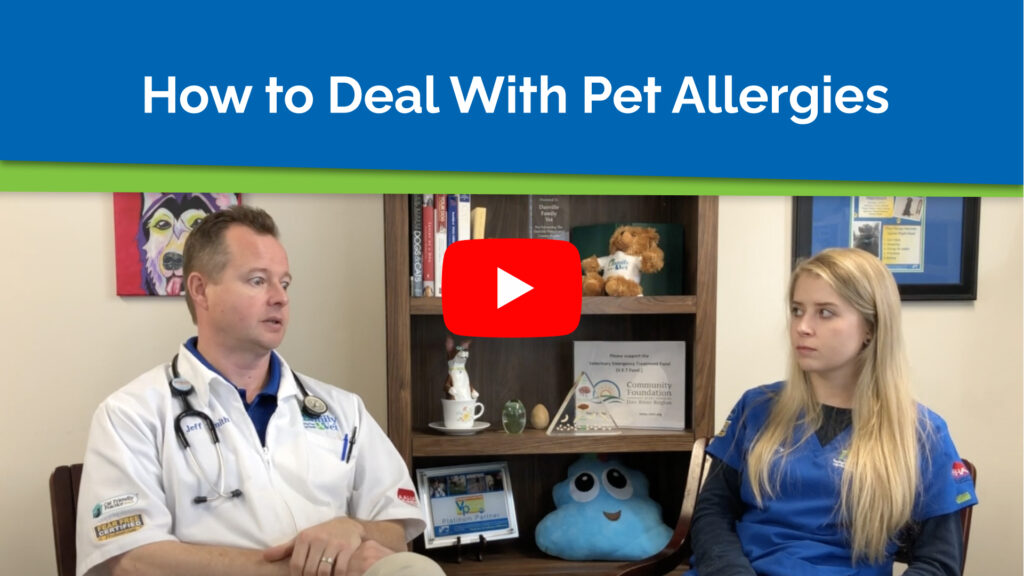A lot of times people think because it’s fall, and the leaves are changing, and there are different pollen, that the problem with their pet is automatically an allergy. It is true that dogs and cats, when they have allergies, react differently than humans do. When we have allergies, we have runny eyes and nose and show symptoms of hay fever. When dogs and cats have allergies, they usually have problems with their skin. They can breathe in the pollen and experience a breakout on their skin. Allergies are typically a good guess, but oftentimes people call the vet when their pet has allergies, and can’t be diagnosed without bringing the pet in the office because there are so many possibilities as to what it could be.
Dogs that are truly allergic can take an oral pill every day, get injections, or use medicated shampoo and extra supplements, such as Omega-3, to combat allergies. Every dog and cat is different, and most times it can be frustrating at first to find the perfect combination that will work. It is important to take note of things that have changed in your pets environment, such as, weather, new places you may have taken your dog, or changes in your house, like laundry detergent or food. If your pet does have allergies, we can find the magic combination to combat allergies based on these observations.
Allergies are like a fire. If you have allergies the fire is always going but it might just be some coals that are smoldering and are under control. As soon as you add pollen, or any other allergy instigator, the fire gets out of control and we have to use different medications and interventions to try and control it.
What Can You Do to Prevent Allergic Reactions at Home?
Fleas are one allergen that can easily be prevented. Most dogs that have allergies are almost always allergic to fleas. If you can solve the flea problem it takes some fuel out of the fire and calms the reaction down. Your pet may still have allergies to pollens and grasses, but these can be managed seasonally by keeping them out of the grass on walks and other times they are outside.
Allergies can be broken up into three separate groups. The first being flea allergies because of how common it is and its significance. The second is environmental or seasonal allergies. These are the allergens outside that we are allergic to as well. In fall, there is mold on the leaves as they fall and families turn their heat on for the first time exposing dust mites. Your pet may be allergic to any of these allergens just like we are and they can start to break out. Your pets seasonal allergies can be prevented by replacing air filters, adopting new walking habits, or keeping them away from grasses that they seem allergic to.
The third and final type of allergy is food allergies. You may hear a lot about what others are feeding their pets and how they are experimenting with different foods mainly because of the TV advertising and marketing. In reality, food allergies are the rarest of the three. Oftentimes, when you visit your vet about allergies, they will hold off on discussing types of food because that most likely isn’t the problem. There are some signs that might indicate to your veterinarian that your dog is allergic to their food, such as, where they are itching, how badly they are breaking out, and even the breed.
What Do You Do if You Suspect that Your Dog has a Food Allergy?
If your dog has a food allergy it means that they are allergic to a protein in the food. Dogs are almost never allergic to plant proteins. Humans who have gluten allergies are allergic to the wheat protein and have to cut wheat out of their entire diet. This almost never happens in dogs, so you don’t have to worry about gluten or grain free food. The meat proteins in your dog’s food are what you need to be worried about.
Dog food companies have lower standards than human food companies, so when they make the dog food they process it in an assembly and make tons of dog food in a day. These companies don’t have to clean their machines in between batches of food so remains of the chicken and gravy meals might get mixed in with the beef and stew meals. These remnants aren’t a worry to the dog food companies because it doesn’t make a dog sick but if your dog is allergic to chicken and there are traces of chicken in their “beef” labeled package it may cause an allergic reaction.
To eliminate these proteins you have to switch your dog to a special food and eliminate all the other proteins from their diet. A hydrolyzed food diet is helpful for dogs with food allergies because it breaks down the protein far enough that the immune system can’t even recognize it. This allows your dog to consume the same amount of protein without setting off the allergy system. Since hydrolyzed food is different from normal dog food, your dog will take time to adapt to it through a slow transition or they may get sick. Once your dog is on the hydrolyzed food, that is all they can eat for 90 days. Sadly, that means no treats, rawhide chews, or any beef flavored toys. If you can eliminate all those things and your dog has a true food allergy it is a miracle to watch everything clear up as they stop taking any medication they were on. Hydrolyzed food is a prescription diet and can be purchased at Danville Family Vet.

